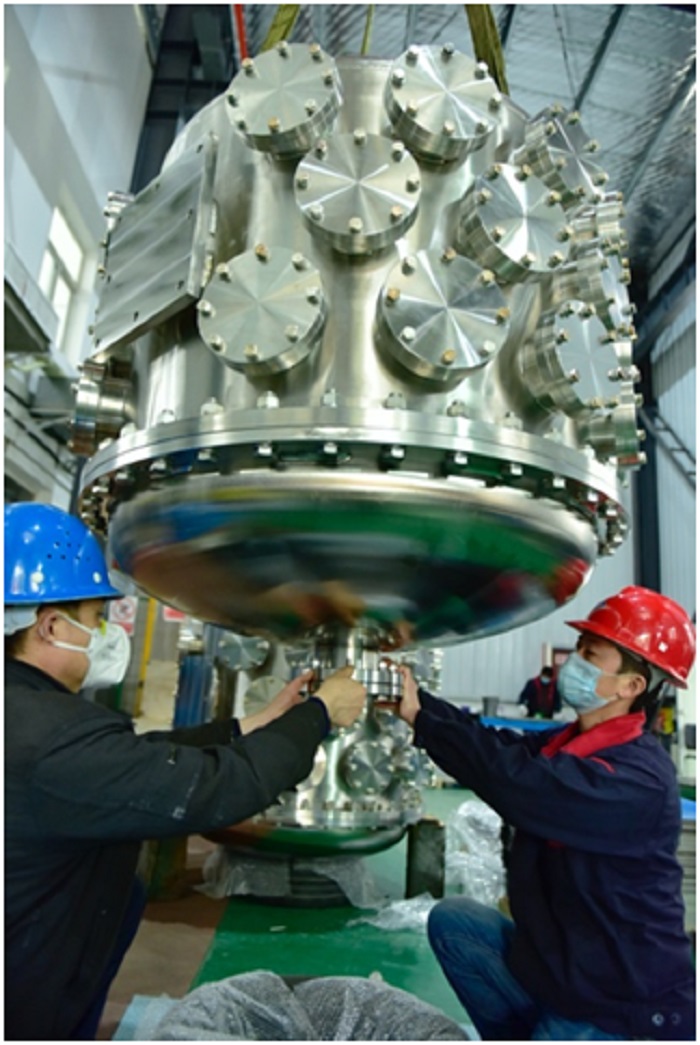



Not long ago, the official start of the assembly of the main part of the International Thermonuclear Experimental Reactor (ITER) program jointly participated by the European Union (EU), China, India, Japan, South Korea, Russia and the United States marked mankind’s another step closer to the dream of creating an “artificial sun”.
As is known to all, nuclear fission is the energy source of nuclear power stations and atomic bombs today. In contrast to nuclear fission, during which a large atomic nucleus releases “fission energy” while being split into smaller nuclei under the impact of neutrons, nuclear fusion refers to the reaction in which two lighter atomic nuclei (mainly isotopes of hydrogen) release energy while being combined to form a heavier atomic nucleus.
Nuclear fusion happens all the time inside the sun, which serves as the most universal energy source of nature.
Nuclear fusion is environmentally friendly. It enjoys unlimited resources and does not create any long-lived highly radioactive waste. Because of these features and other advantages, fusion energy is considered one of the ideal clean energy sources.
Mankind dreams of creating a nuclear fusion reactor on earth and making it provide endless energy for them like the sun does. Such a reactor is commonly known as “artificial sun”. The goal of the ITER program is to verify the feasibility of controlled nuclear fusion in science and engineering.
Although the scientific principles seem pretty clear, it is very difficult to realize controlled thermonuclear fusion reaction. It requires extremely high temperatures of hundreds of millions of degrees Celsius and simultaneously certain density of atomic nuclei for a long enough period of time (confinement time).
In the 1950s, a British scientist proposed a classic equation named Lawson criterion, which specifies that for fusion to take place, the product of the plasma density (nd) and confinement time (τ) has to satisfy the inequality: ndτ≥3×1020s/m3.
According to Lawson criterion and the characteristics of nuclear fusion, nuclear fusion reaction between deuterium and tritium, isotopes of hydrogen, has been proven the easiest nuclear fusion reaction, which is also the focus of the current research in the field.
The implementation of the ITER program has basically been divided into three stages. The program entered its first stage, which is mainly centers around construction, in 2006. Relevant assembly and commissioning job of the program is expected to be completed by 2025. The reactor will then be able to produce high-temperature plasma (ionized gas) that meets the conditions for nuclear fusion in terms of temperature, density, and confinement time.
The time between 2025 and 2037 will be the operation period of the ITER experimental device. There will also be a five-year period of deactivation in the ITER program to make sure the reaction materials are cooled and safe for the environment.
Except for generating electricity, ITER program will basically verify or solve all the key problems in physics, engineering, and science baffling controlled nuclear fusion power generation for commercial power stations in the future.
The ITER program is time-consuming for four major reasons. First of all, the program includes many difficult construction tasks, such as the world’s largest magnet system, ultra-high vacuum system, power supply system, and cooling system.
Secondly, as both a science program and engineering project, the ITER has no success stories to draw lessons from, which makes it rather difficult to make decisions in certain links. Besides, the program involves an enormous amount of repeated scientific and engineering verification.
Thirdly, the implementation of the program has met huge challenges in project management, as the procurement and production of many key systems in the program have involved multiple parties with different strength and following different regulations.
Fourthly, the ITER program includes many participants from diverse cultural backgrounds. Changes in the economic and political situation of certain countries participating in the program also exert direct influence on the implementation of the program.
The ITER program needs to go through the demonstration reactor experiments before the realization of the commercial use of controlled nuclear fusion.
In an effort to narrow the gap between the ITER and the future nuclear fusion power stations, Chinese scientists proposed building the China Fusion Engineering Test Reactor (CFETR), suggesting starting the construction of China’s demonstration fusion power station and the commercial development of fusion energy around the middle of the century.
With the support from the ITER, China completed the conceptual designs of the CFETR in 2014, and is now busy working on detailed physical engineering designs, preliminary research on key technologies as well as research and development of materials for the fusion reactor. Relevant work has included participants from various parties in the international community.
While faced with huge challenges, the commercial use of nuclear fusion has a far-reaching influence on the world, will drive the development of various fields, and requires joint efforts and constant exploration of scientists and governments of various countries in the world.


The Humanitarian Service Diamond Awards has.
A Chinese Company, Inner Galaxy Steel.


The Programme Coordinator, Regulatory, Compliance and.


A Non-Governmental Organization (NGO), Committee for.
The Trustfund Pensions Limited has chided.


The House of Representatives Committee on.
The China General Chamber of Commerce.


Senator Chuka Utazi who represented Enugu.


An Abuja based Legal Practitioner, Ugochukwu.


The African business community in Yiwu,.
Leave a Comment